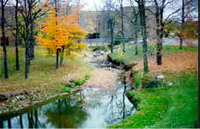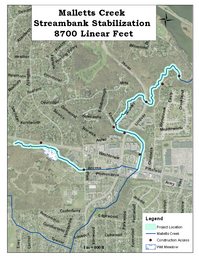Malletts Creek stream restoration and construction begins

Research Park
Storm water runoff continues to be the primary cause of water pollution in the Huron River. Eroded soil and phosphorus threaten aquatic habitat and cause algae blooms; while oils, heavy metals, E. coli and salt contaminate the river each time it rains. Malletts Creek is the largest waterway in the City of Ann Arbor, and it contributes the highest share of pollutants to the river.
Since developing the Malletts Creek Restoration Plan in 2000, the City of Ann Arbor and the Washtenaw County Office of the Water Resources Commissioner have partnered with the Michigan Department of Environment Quality (DEQ) to reduce high flows, improve water quality and stabilize the Malletts Creek corridor.

One result of this collaboration is the water quality treatment wetland at Mary Beth Doyle Park completed in 2008. The wetland holds 15 million gallons of storm water before releasing it slowly back to Malletts Creek. This helps stabilize flow after a storm.
Smaller projects also help. Stricter stormwater treatment standards for re-development, homeowner-installed rain gardens and rain barrels also have a positive impact.
One way to speed up the stream stabilization process is to reinforce the stream channel in critical areas such as turns and road crossings, using a combination of re-grading, rock armoring and native vegetation. Recently the MDEQ awarded the Washtenaw County Water Resource Office a combination of green infrastructure grants and lowâ€interest loans worth $2.8 million for stream bank stabilization in Malletts Creek (see map).
The work began on Sept. 27 and will continue through spring. The project is expected to prevent 685 tons of erosion (roughly a football field 1 and 1/2 feet deep) and reduce phosphorus entering the river by 15 percent annually.
Impacts include temporary equipment access from the eastbound lane of Washtenaw Avenue into County Farm Park. No lane closures are expected. Construction traffic will also access the creek along Huron Parkway, Platt, Chalmers and Exmoor.
Areas disturbed by construction will have non-native species removed and replaced with native vegetation. Staff from the City of Ann Arbor’s Natural Area Preservation (NAP) office and the Washtenaw County Parks and Recreation Commission have been active throughout the design process.
The County Farm Park segment includes improvements that are highly visible to the public. This work involves construction of a three-acre wet-meadow west of the Meri Lou Murray Recreation Center and south of the existing Washtenaw Avenue bike path.
A public hearing was held on the project in June of 2010, public notices were sent to properties along the creek and individual sessions were held with the Huron Chase Condominium Association and some residents along the creek.
For further information, please contact Harry Sheehan at 222â€6851 or sheehanh@ewashtenaw.org. A full plan set can be provided upon request.
Nicole (Lowen) Berg is the MRF education center and special projects coordinator at the City of Ann Arbor. Nicole can be reached at nlowen@a2gov.org. Visit www.a2gov.org for more information on local environmental topics including recycling, composting, water conservation, and choices for green living.
Your World provides local environmental information to our community. Contributing partners include: Washtenaw County’s Environmental Health Division; the nonprofit Recycle Ann Arbor; the City of Ann Arbor’s Public Services Area, Natural Area Preservation, Systems Planning programs for Energy, Environmental Coordination, Solid Waste, Transportation, and Water Resources.


Comments
lefty48197
Thu, Dec 8, 2011 : 10:48 p.m.
I understand that there are many reasons for wanting to control stormwater run-off. For new construction, the best way to handle stormwater is to have it stored in temporary above ground, or underground "ponds". These ponds keep the water from entering the city's main storm sewer system, keeps the creeks from swelling too much and these things help minimize erosion, oil and chemical run-off etc. Recently a system of underground ponds was installed in the Pioneer High parking lot, keeping the storm water from that property out of the city system during rainy periods. I also watched the underound pond system get installed in the Whole Foods shopping center on Washtenaw. It's relatively easy to install these systems on city owned property or to demand that developers install them as part of any new development project. What about old private properties that don't have any systems like this in place? There are probably some large parcels of land in Ann Arbor that dump all of their stormwater run-off directly into the city storm sewer system immediately, without any retention ponds to delay the run-off. Is the city going to try an do anything to rectify any problems like this that may exist? Also, it seems like it would be a good idea to have some sort of retention/detention pond system for the creek system that exists. It sounds like that's what they're doing at Platt and Washtenaw. This is a progressive use of tax dollars and the type of system that communities all across the country should be doing as resources allow.